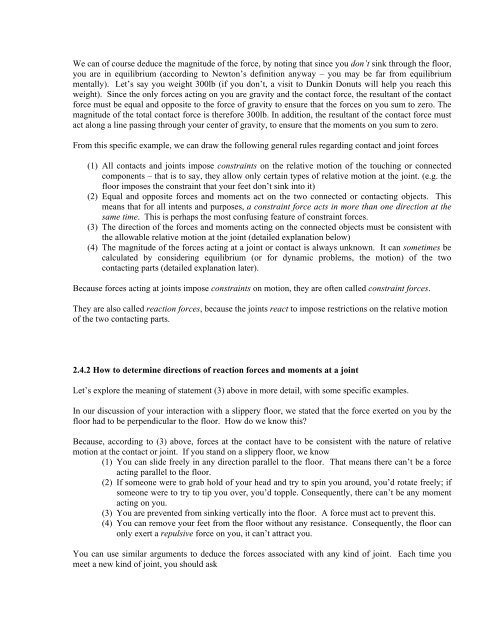Chapter 2 Review of Forces and Moments - Brown University
Chapter 2 Review of Forces and Moments - Brown University
Chapter 2 Review of Forces and Moments - Brown University
Create successful ePaper yourself
Turn your PDF publications into a flip-book with our unique Google optimized e-Paper software.
We can <strong>of</strong> course deduce the magnitude <strong>of</strong> the force, by noting that since you don’t sink through the floor,<br />
you are in equilibrium (according to Newton’s definition anyway – you may be far from equilibrium<br />
mentally). Let’s say you weight 300lb (if you don’t, a visit to Dunkin Donuts will help you reach this<br />
weight). Since the only forces acting on you are gravity <strong>and</strong> the contact force, the resultant <strong>of</strong> the contact<br />
force must be equal <strong>and</strong> opposite to the force <strong>of</strong> gravity to ensure that the forces on you sum to zero. The<br />
magnitude <strong>of</strong> the total contact force is therefore 300lb. In addition, the resultant <strong>of</strong> the contact force must<br />
act along a line passing through your center <strong>of</strong> gravity, to ensure that the moments on you sum to zero.<br />
From this specific example, we can draw the following general rules regarding contact <strong>and</strong> joint forces<br />
(1) All contacts <strong>and</strong> joints impose constraints on the relative motion <strong>of</strong> the touching or connected<br />
components – that is to say, they allow only certain types <strong>of</strong> relative motion at the joint. (e.g. the<br />
floor imposes the constraint that your feet don’t sink into it)<br />
(2) Equal <strong>and</strong> opposite forces <strong>and</strong> moments act on the two connected or contacting objects. This<br />
means that for all intents <strong>and</strong> purposes, a constraint force acts in more than one direction at the<br />
same time. This is perhaps the most confusing feature <strong>of</strong> constraint forces.<br />
(3) The direction <strong>of</strong> the forces <strong>and</strong> moments acting on the connected objects must be consistent with<br />
the allowable relative motion at the joint (detailed explanation below)<br />
(4) The magnitude <strong>of</strong> the forces acting at a joint or contact is always unknown. It can sometimes be<br />
calculated by considering equilibrium (or for dynamic problems, the motion) <strong>of</strong> the two<br />
contacting parts (detailed explanation later).<br />
Because forces acting at joints impose constraints on motion, they are <strong>of</strong>ten called constraint forces.<br />
They are also called reaction forces, because the joints react to impose restrictions on the relative motion<br />
<strong>of</strong> the two contacting parts.<br />
2.4.2 How to determine directions <strong>of</strong> reaction forces <strong>and</strong> moments at a joint<br />
Let’s explore the meaning <strong>of</strong> statement (3) above in more detail, with some specific examples.<br />
In our discussion <strong>of</strong> your interaction with a slippery floor, we stated that the force exerted on you by the<br />
floor had to be perpendicular to the floor. How do we know this?<br />
Because, according to (3) above, forces at the contact have to be consistent with the nature <strong>of</strong> relative<br />
motion at the contact or joint. If you st<strong>and</strong> on a slippery floor, we know<br />
(1) You can slide freely in any direction parallel to the floor. That means there can’t be a force<br />
acting parallel to the floor.<br />
(2) If someone were to grab hold <strong>of</strong> your head <strong>and</strong> try to spin you around, you’d rotate freely; if<br />
someone were to try to tip you over, you’d topple. Consequently, there can’t be any moment<br />
acting on you.<br />
(3) You are prevented from sinking vertically into the floor. A force must act to prevent this.<br />
(4) You can remove your feet from the floor without any resistance. Consequently, the floor can<br />
only exert a repulsive force on you, it can’t attract you.<br />
You can use similar arguments to deduce the forces associated with any kind <strong>of</strong> joint. Each time you<br />
meet a new kind <strong>of</strong> joint, you should ask
















